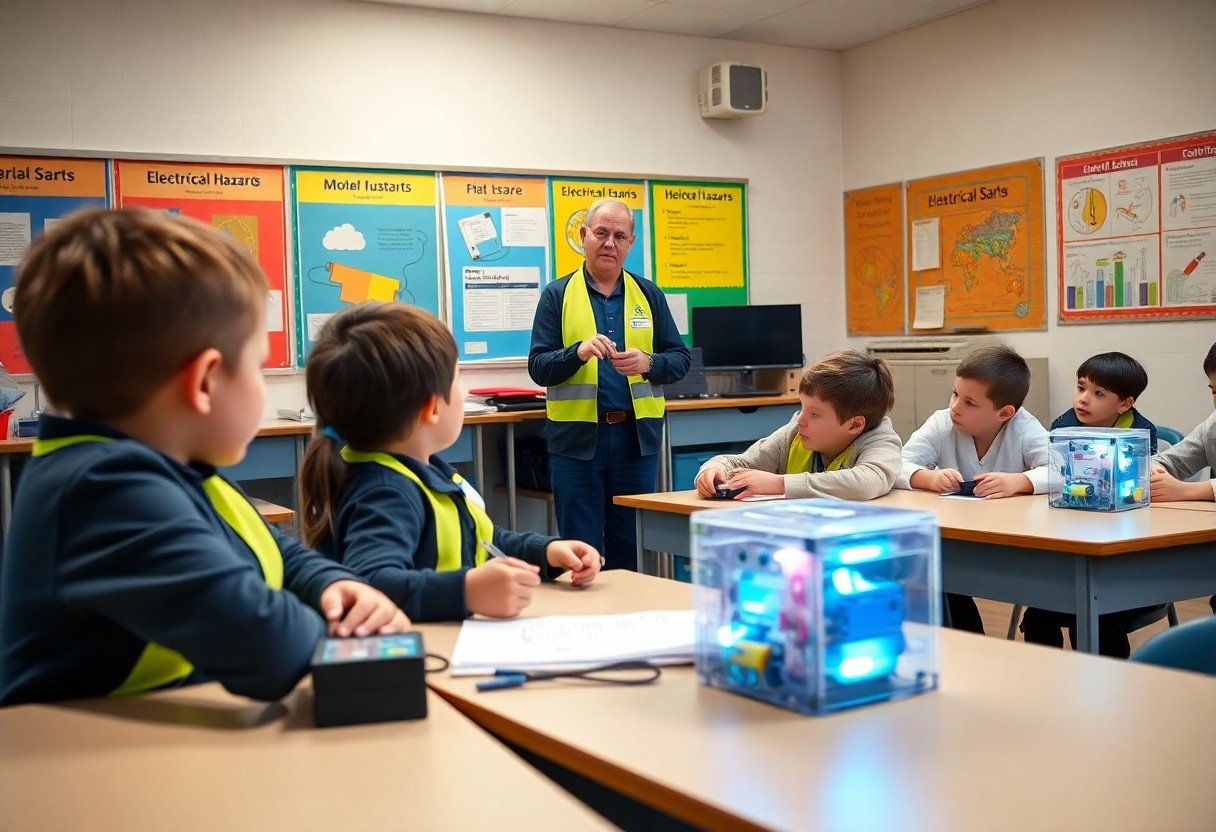Most parents want their children to be safe around electricity, which is why South Auckland schools are implementing effective educational programs. These initiatives provide you with the tools to teach your kids about electrical hazards and safe practices at home and beyond. By engaging students in practical demonstrations and interactive lessons, this program equips you with the knowledge to instill crucial safety habits in your children, ensuring they understand the importance of electrical safety from a young age.
Key Takeaways:
- Program aims to educate children about safe practices around electricity.
- Interactive demonstrations enhance understanding of electrical hazards.
- Focus on practical safety tips for home and school environments.
- Engages local community and parents in discussions about safety.
- Encourages children to take responsibility for their own safety.
Importance of Electrical Safety Education
You play a fundamental role in ensuring that your children understand the importance of electrical safety education. This knowledge not only protects them from potential dangers but also empowers them to make informed choices in their daily lives. By providing proper guidance and resources, you’re cultivating a generation that is aware and responsible when it comes to handling electrical appliances and situations.
Understanding the Risks
Children often lack a complete grasp of the risks associated with electricity. Unsafe interactions, such as playing with cords or outlets, can lead to severe injuries or fatalities. Statistics reveal that in New Zealand, hundreds of injuries every year are attributable to electrical accidents among children, underscoring the necessity of instilling safety awareness from a young age.
Benefits for Children
Educating your children about electrical safety fosters not only their well-being but also instills a sense of responsibility. They gain confidence in recognizing hazardous situations and understanding safe behaviors around electricity, which are important life skills. Programs like the one in your community serve to reinforce these lessons through interactive learning experiences.
Children who engage in electrical safety education often develop critical thinking skills. They learn to assess risks effectively and are more likely to communicate safety concerns with adults. For instance, kids taught about electrical hazards can recognize unsafe situations, like frayed cords or wet areas near outlets, and immediately alert an adult. This proactive approach can drastically reduce the likelihood of accidents in your home and community, establishing a safer environment for everyone.

The Curriculum Structure
The curriculum for the electrical safety program is designed to blend theoretical knowledge with engaging, hands-on experiences. Each lesson builds upon the last, ensuring that students grasp fundamental electrical concepts before progressing. The structure includes interactive presentations, group discussions, and assessments that reinforce learning objectives while promoting critical thinking about safety practices.
Age-Appropriate Learning
Your children will explore electrical safety through tailored lessons that match their developmental stages. Younger students focus on identifying safe and unsafe situations through storytelling and visuals, while older students explore into the science of electricity, understanding circuits, and safety protocols relevant to their everyday lives.
Practical Applications
To reinforce learning, practical applications are woven into the program. Activities include real-life simulations, such as role-playing emergency scenarios and using safety equipment. These experiences help students translate theoretical knowledge into responsible behaviors, preparing them for potential hazardous situations they may encounter at home and in their communities.
Incorporating practical applications not only enhances retention but also builds confidence in your child’s ability to handle electrical situations safely. For example, during a hands-on workshop, students might work with miniature circuits to understand how different components function safely. By participating in simulated emergencies where they must respond appropriately to electrical hazards, they gain valuable skills. Ultimately, these interactive experiences foster a proactive mindset towards electrical safety, equipping your child to make informed decisions in real-world scenarios.
Interactive Learning Methods
The program emphasizes interactive learning methods, allowing students to actively engage with electrical safety concepts. Students participate in various activities that not only enhance understanding but also make the learning experience enjoyable. By incorporating techniques like hands-on activities and engaging demonstrations, you can witness how these methods effectively reinforce the importance of electrical safety in everyday situations.
Hands-On Activities
Hands-on activities are integral to the program, enabling students to apply what they’ve learned in practical scenarios. You will see students building circuits with safe materials, allowing them to understand how electricity flows while recognizing potential hazards. This tactile approach fosters a deeper comprehension of electrical safety principles and encourages students to think critically about their surroundings.
Engaging Demonstrations
Engaging demonstrations play a vital role in illustrating electrical safety concepts. You’ll find that these demonstrations often include real-life scenarios, such as simulating what happens when appliances are used improperly. By visualizing these situations, students gain a clearer understanding of the consequences of electrical accidents, heightening their awareness and responsibility in daily life.
One effective demonstration involves using a simple circuit board to show how electricity travels. As students observe the circuit’s function, they also see how certain components can cause overloads. This visual representation makes it easier for you to convey the importance of using household devices correctly. Additionally, bringing in a local electrician to discuss their experiences with electrical safety incidents adds a personal and relatable touch, inspiring students to take the topic seriously.

Collaboration with Parents and Community
Your involvement can significantly enhance the impact of the electrical safety program. Partnering with parents and local community organizations fosters a supportive environment for learning. By sharing resources and information, such as those found in the Youth Safety Programs, you create a network of safety advocates who can emphasize these important lessons beyond the classroom.
Involving Parents in Education
Outreach Programs
Community outreach initiatives help spread awareness of electrical safety beyond school walls. By organizing events at local fairs or community centers, you reach families who may not be aware of the importance of these lessons. Involving local electricians or safety professionals as guest speakers can further enrich these outreach efforts.
Outreach programs can include safety demonstrations, interactive booths, and distribution of educational materials. By hosting community events, you enable families to learn together and ask questions in a relaxed setting. These initiatives not only educate but also foster camaraderie among participants, creating a culture of safety that extends throughout your entire community.
Evaluating Program Effectiveness
To ensure the electrical safety program meets its objectives, you must evaluate its effectiveness through structured methodologies and participant feedback. This evaluation process will help identify strengths and areas for improvement, ultimately enhancing the program’s quality and impact on students’ understanding of electrical safety practices.
Assessment Methods
Utilizing both pre- and post-program assessments allows you to measure knowledge gains effectively. Surveys containing true/false and multiple-choice questions provide quantifiable data, while practical demonstrations enable you to evaluate students’ ability to apply what they have learned in real-life scenarios. Incorporating observations of student engagement during workshops also offers insight into the program’s effectiveness.
Feedback from Participants
Engaging participants in feedback sessions post-program is crucial for gauging effectiveness. Utilize structured surveys and informal discussions to capture their experiences and insights regarding the curriculum content, delivery methods, and overall value.
Feedback from participants has highlighted key areas of the program’s impact. For instance, 85% of students reported an increased understanding of electrical hazards, while parents noted a significant improvement in their children’s safety awareness at home. Additionally, incorporating a suggestion box allowed students to voice their thoughts and recommendations, further enriching future iterations of the program. Combining quantitative data with qualitative insights creates a comprehensive evaluation that guides continuous enhancement of the curriculum.
Future of Electrical Safety Education
The evolution of electrical safety education hinges on adaptability and innovation to meet the future needs of students. By integrating modern technology and engaging teaching methods, schools can enhance students’ understanding and retention of critical safety information. As awareness of electrical hazards continues to grow, the burden falls on educational programs to evolve and provide enticing yet informative experiences that resonate with today’s youth.
Expanding the Program
To broaden the reach of the electrical safety program, engage more schools and communities by tailoring content to diverse learning environments. Developing partnerships with local organizations can facilitate workshops and resource sharing, allowing students from various backgrounds to benefit from important safety knowledge. This expansion efforts create a community-wide safety culture that reinforces learning beyond the classroom.
Innovations in Teaching Approaches
Incorporating cutting-edge teaching strategies can make your electrical safety program more effective and engaging. Using interactive tools like virtual reality and gamified learning experiences captivates students, helping them grasp complex concepts in a fun manner. You could integrate real-life scenarios through simulations that demonstrate the dangers of electrical mishaps and the importance of safety protocols.
Virtual reality is becoming increasingly accessible, allowing students to navigate simulated environments where they can practice electrical safety without risk. These immersive experiences enable learners to visualize consequences and encourage retention of safety practices. Gamified platforms also facilitate group participation and friendly competition, motivating students to learn while allowing for a deeper understanding of electrical safety principles. By using these innovative approaches, you can foster a more impactful and memorable educational experience.
Summing up
From above, you can see how important it is for pupils to understand electrical safety through the South Auckland School’s program. By engaging with informative materials and hands-on demonstrations, you equip your children with vital skills to recognize potential hazards and respond appropriately. This proactive approach not only enhances their safety at school and home but also fosters a culture of awareness that extends into their everyday lives. Empower your kids to make safe choices around electricity, ensuring their wellbeing and instilling good habits that last a lifetime.
FAQ
Q: What is the purpose of the ‘Teaching Kids About Electrical Safety’ program?
A: The program aims to educate children about the dangers of electricity, safe practices at home and school, and how to respond in emergency situations involving electrical hazards.
Q: Who conducts the electrical safety sessions in South Auckland schools?
A: The sessions are conducted by trained safety educators, often in collaboration with local electrical safety organizations and community volunteers.
Q: What age group is the program designed for?
A: The program is primarily targeted at children aged 5 to 12 years, ensuring that safety concepts are age-appropriate and engaging.
Q: How long does the electrical safety program last?
A: Each session typically lasts about one hour, but the total duration may vary based on the school’s schedule and the number of classes participating.
Q: Are there any materials or resources provided for students after the sessions?
A: Yes, students receive informative handouts and resources that reinforce the topics covered during the lessons, including tips for safe practices and emergency contact information.
